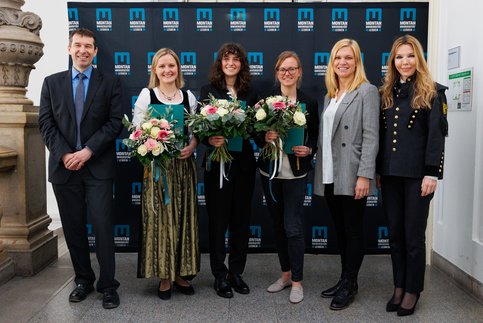Every year, the Montanuniversität awards the Science Prize for female montanists to scientists and students for outstanding achievements in research.
Based on the different stages of a scientific career, the science prize is awarded in four categories: PostDoc, PraeDoc, Master and Bachelor. The award is intended to emphasise the achievements of women against the backdrop of International Women's Day.
The award winners were selected by a high-calibre committee. The selection criteria for the science prize are exceptional research performance, scientific excellence, the significance of the research results for the further development of the department, the high application potential and the lasting impact of the work performed.
Eva Wegerer, MBA, Chair of the Equal Opportunities Working Group, emphasises: "The award winners are role models for young women who are interested in technical fields of study." The prize is endowed with a total of 8,000 euros. The event was rounded off with a presentation by Susanne Feiel, Head of the International Relations and European University Service Department at Montanuniversität.
POSTDOC category: Ass.-Prof. Dipl.-Ing. Dr.mont. Barbara Putz
Chair of Structural and Functional Ceramics
Barbara Putz, who was born in Leoben, is an assistant professor at the Department of Materials Science. Barbara Putz's field of research includes the development of thin-film systems that can be used in micro and flexible electronics as well as in space travel. In everyday life, this technology is used in mobile phones, rescue blankets and as insulation material for satellites.
As part of Barbara Putz's research work, a unique deposition structure was developed to produce metal oxide nanolaminate films on flexible polymers. Mechanical tests were carried out at the synchrotron to analyse the deformation behaviour. It was found that the crack resistance of the films increases with increasing density of the oxide layer. A biaxial yield surface model of the films was developed to describe the mechanical behaviour under multiaxial loading conditions. This is of great importance for the application in various flexible carrier systems and load cases in electronics.
Category PRAEDOC: Dipl.-Ing. Kathrin Thiele
Lehrstuhl für Eisen- und Stahlmetallurgie
Kathrin Thiele comes from southern Styria and is a PhD student in the Christian Doppler Laboratory for Inclusion Metallurgy in Modern Steelmaking. The introduction to the study of metallurgy at the Montanuniversität convinced Kathrin Thiele that it is possible to make an active contribution to combating climate change.
A current research focus in metallurgy is CO2-transformation and CO2-free steel production. This research focus gives rise to new challenges and requirements for which Kathrin Thiele's inclusion metallurgy is used. Kathrin Thiele's research work focusses on the tracking of non-metallic inclusions (NME) in steels. The formation of NMEs and their modifications have a major influence on steel quality and the production process. In this project, the optimisation of the active tracing method is being investigated both on a laboratory and industrial scale. In addition, the characterisation of marked MNE will be carried out using artificial intelligence. An innovative method based on the rare earth fingerprint is used to determine the origin of MNE. Purity plays a particularly important role in steels for the automotive industry.
BACHELOR category: Antonia Siebenbrunner
Lehrstuhl für Allgemeine und Analytische Chemie
Antonia Siebenbrunner's bachelor thesis was written as part of the MURmap project, which is concerned with the geochemical characterisation of the River Mur. As part of her bachelor's thesis, Antonia Siebenbrunner worked on the development of a method for the in-situ determination of strontium (Sr) concentrations and isotope ratios in natural waters using DGT passive samplers. In the course of the research work, the concentrations of other elements such as lead, barium and calcium were also determined.
The aims of the work included validation in the laboratory, testing the samplers in controlled experiments and investigating time-integrated passive sampling. Mass spectrometric methods were used for element quantification and isotope ratio analysis of 87Sr/86Sr. The samplers were successfully used in a one-week field trial. Antonia Siebenbrunner intends to use the method in a further research step in another area of the Mur.
MASTER category: Dipl.-Ing. Christina Pölzl
Chair of Mineral Processing
Christina Pölzl comes from Mürzzuschlag and studied at the Chair of Mineral Processing at the University of Leoben. Christina Pölzl wrote her Master's thesis during a seven-month research stay in Boston. Christina Pölzl co-operated with the US company ST Equipment & Technology LLC (STET). In her Master's thesis, Christina Pölzl focussed specifically on a sustainable alternative for processing very fine iron ore.
In her scientific work, Christina Pölzl is investigating dry iron ore processing using electrostatic separation. The process is optimised using statistical design (DoE) and the JMP software. The aim is to produce high-quality iron ore concentrates by using the triboelectric separator from STET, which complements the current process of dry magnetic separation. The electrostatic separator, which was specially developed for fine material, fulfils the production quality standards. This application represents a step forward in the iron ore industry as it responds to the challenges of water scarcity and environmental problems, particularly in relation to chemical pollution and dam breakage.
More information & contact
Dipl.-Ing. Dr. Eva Wegerer, MBA
Chairwoman of the Working Group for Equal Treatment Issues
Phone: +43 3842 402 7004
E-Mail: eva.wegerer(at)unileoben.ac.at

